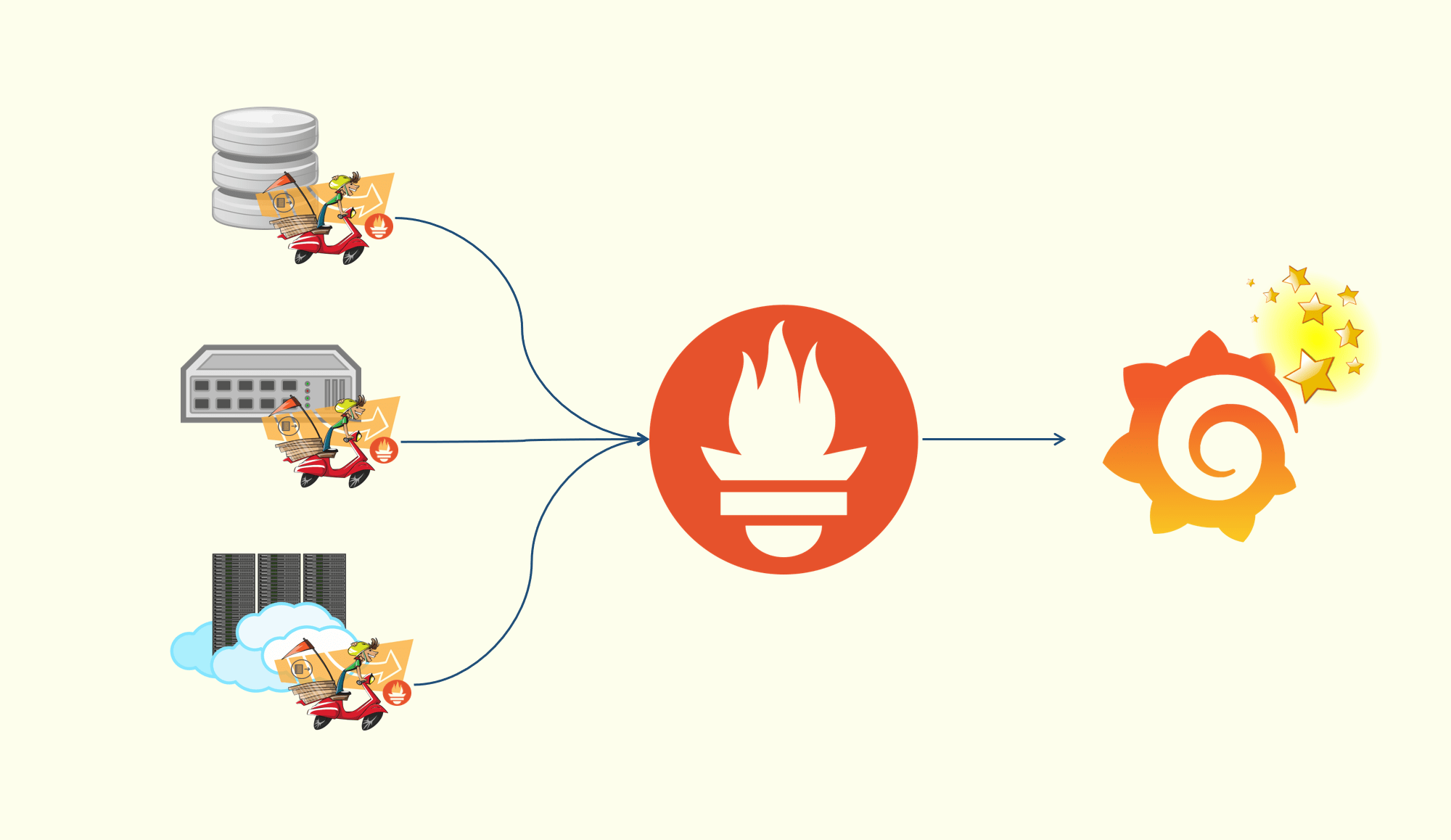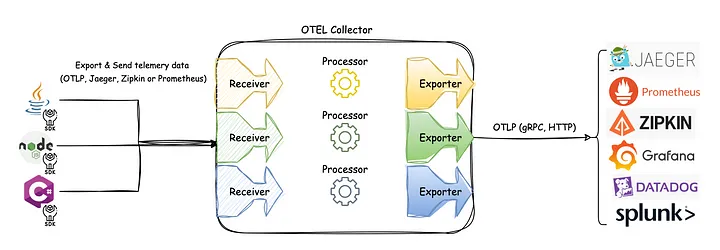Data model
Prometheus fundamentally stores all data as time series
streams of timestamped values belonging to the same metric and the same set of labeled dimensions .
Besides stored time series , Prometheus may generate temporary derived time series as the result of queries .
Metric names and labels Every time series is uniquely identified by its metric name and optional key-value pairs called labels .
Metric names
Metric names SHOULD specify the general feature of a system that is measured
e.g. http_requests_total - the total number of HTTP requests received
Metric names MAY use any UTF-8 characters.
Metric names SHOULD match the regex [a-zA-Z_:][a-zA-Z0-9_:]* for the best experience and compatibility (see the warning below).
Metric names outside of that set will require quoting e.g. when used in PromQL
Colons (‘: ‘) are reserved for user-defined recording rules . They SHOULD NOT be used by exporters or direct instrumentation .
Metric labels
Labels let you capture different instances of the same metric name .
For example: all HTTP requests that used the method POST to the /api/tracks handler.
We refer to this as Prometheus’s “dimensional data model “.
The query language allows filtering and aggregation based on these dimensions .
The change of any label’s value , including adding or removing labels , will create a new time series .
Label names MAY use any UTF-8 characters.
Label names beginning with __ (two underscores) MUST be reserved for internal Prometheus use .
Label names SHOULD match the regex [a-zA-Z_][a-zA-Z0-9_]* for the best experience and compatibility (see the warning below).
Label names outside of that regex will require quoting e.g. when used in PromQL
Label values MAY contain any UTF-8 characters.
Labels with an empty label value are considered equivalent to labels that do not exist .
WARNING
The UTF-8 support for metric and label names was added relatively recently in Prometheus v3.0.0 .
It might take time for the wider ecosystem to adopt new quoting mechanisms , relaxed validation etc.
downstream PromQL compatible projects and vendors, tooling, third-party instrumentation, collectors, etc.
For the best compatibility it’s recommended to stick to the recommended (“SHOULD “) character set.
1 2 3 4 5 6 7 8 9 10 11 12 13 14 15 16 17 18 19 20 21 22 23 24 25 26 27 28 29 30 31 32 33 34 35 36 37 指标名称 (Metric Names) 基本规则 - 目的: 指定系统测量的通用特征(如 http_requests_total - HTTP请求总数) - 字符: 可使用任何UTF-8字符 - 推荐格式: 应匹配正则表达式 [a-zA-Z_:][a-zA-Z0-9_:]* - ⚠️ 重要限制: - 冒号 (:) 保留给用户定义的记录规则 - 导出器或直接仪表化不应使用冒号 标签 (Labels) 标签名称规则 - 作用: 捕获同一指标名称的不同实例(如POST方法、/api/tracks处理器的HTTP请求) - 字符: 可使用任何UTF-8字符 - 内部保留: 以 __ 开头的标签名称保留给Prometheus内部使用 - 推荐格式: 应匹配正则表达式 [a-zA-Z_][a-zA-Z0-9_]* 标签值规则 - 字符: 可包含任何UTF-8字符 - 空值处理: 空标签值等同于标签不存在 - 时间序列: 任何标签值的变更(包括添加/删除标签)都会创建新的时间序列 维度数据模型 Prometheus的"维度数据模型"允许查询语言基于这些维度进行过滤和聚合。 兼容性警告 - UTF-8支持: 在Prometheus v3.0.0中新增 - 生态兼容: 整个生态系统(PromQL兼容项目、工具、第三方仪表化等)采用新引用机制需要时间 - 最佳实践: 为最佳兼容性,建议遵循推荐的字符集 这些规则确保了Prometheus指标的一致性和可维护性,同时支持复杂的监控需求。
Samples
Samples form the actual time series data . Each sample consists of:
a float64 or native histogram value
a millisecond-precision timestamp ]
1 2 3 4 5 6 7 8 9 10 11 12 13 14 15 16 17 18 19 20 21 22 23 24 25 26 27 28 29 30 31 32 33 34 35 36 37 38 39 40 41 42 43 44 45 46 47 48 49 50 51 52 53 54 55 56 57 58 59 60 61 62 63 64 65 66 67 68 69 70 71 72 73 74 75 76 77 78 79 80 81 82 83 84 85 86 87 88 89 90 91 92 93 94 95 96 97 98 99 100 101 102 103 104 105 106 107 108 109 110 111 112 113 114 115 Float64 vs Native Histogram Float64 样本 value: 123.45 (单个数值) timestamp: 1695912345678 (毫秒时间戳) Native Histogram 样本 value: { count: 1000 (观察次数) sum: 12345.67 (所有观察值的总和) zero_threshold: 0.001 (零值阈值) zero_count: 50 (零值或接近零值的数量) schema: 1 (增长因子模式) positive_buckets: [ {upper_bound: 0.1, count: 100}, {upper_bound: 1.0, count: 200}, {upper_bound: 10.0, count: 300} ] negative_buckets: [...] (负值桶) } timestamp: 1695912345678 为什么引入 Native Histogram? 1. 存储效率提升 传统方案 (多个指标): http_request_duration_seconds_bucket{le="0.1"} 100 http_request_duration_seconds_bucket{le="0.5"} 200 http_request_duration_seconds_bucket{le="1.0"} 350 http_request_duration_seconds_bucket{le="5.0"} 450 http_request_duration_seconds_bucket{le="+Inf"} 500 http_request_duration_seconds_sum 1234.56 http_request_duration_seconds_count 500 Native Histogram (单个指标): http_request_duration_seconds{...} {包含所有桶信息的一个样本} 2. 性能优势 | 方面 | 传统 Histogram | Native Histogram | |------|--------------|------------------| | 存储空间 | 多个时间序列 | 单个时间序列 | | 查询性能 | 需要关联多个指标 | 单次查询获取所有信息 | | 压缩效率 | 较低 | 更高 | | 网络传输 | 多个样本 | 单个样本 | 3. 精度和灵活性 动态桶边界: - Native histogram 可以动态调整桶的边界 - 基于观察到的数据分布优化桶的设置 - 减少预定义桶边界的猜测工作 更高精度: // 示例:观察延迟分布 histogram.Observe(0.123) // 自动分配到合适的桶 histogram.Observe(45.678) // 根据数据分布动态调整 使用场景对比 Float64 适用场景 # 简单的计数器、仪表盘 cpu_usage_percent 75.5 memory_available_bytes 2147483648 active_connections 150 Native Histogram 适用场景 # 延迟分布、请求大小、响应时间等 http_request_duration_seconds{quantile="0.95"} 2.5 grpc_request_size_bytes{quantile="0.50"} 1024 迁移示例 之前 (传统方式): // Go 客户端传统 histogram hist := prometheus.NewHistogram(prometheus.HistogramOpts{ Name: "http_request_duration_seconds", Help: "HTTP request latency.", Buckets: prometheus.DefBuckets, // [0.005, 0.01, 0.025, 0.05, 0.1, 0.25, 0.5, 1, 2.5, 5, 10] }) 现在 (Native Histogram): // Go 客户端 native histogram hist := prometheus.NewNativeHistogram(prometheus.NativeHistogramOpts{ Name: "http_request_duration_seconds", Help: "HTTP request latency.", // 无需预定义桶,自动优化 }) 查询语法变化 传统查询: # 计算 95th 百分位 histogram_quantile(0.95, rate(http_request_duration_seconds_bucket[5m])) Native Histogram 查询: # 直接查询百分位数 histogram_quantile(0.95, rate(http_request_duration_seconds[5m])) 总结 引入 Native Histogram 的主要动机: 1. 存储效率: 将多个相关的时间序列合并为一个 2. 性能提升: 减少查询时的数据关联操作 3. 精度改进: 动态桶分配提供更精确的数据分布 4. 简化配置: 无需预定义桶边界 5. 网络优化: 减少传输的数据量 这是 Prometheus 在 v2.40 版本引入的重大改进,为大规模监控提供了更好的性能和效率。
Notation Given a metric name and a set of labels , time series are frequently identified using this notation:
1 <metric name>{<label name>="<label value>", ...}
For example, a time series with the metric name api_http_requests_total and the labels method=”POST” and handler=”/messages” could be written like this:
1 api_http_requests_total{method="POST", handler="/messages"}
This is the same notation that OpenTSDB uses.
Names with UTF-8 characters outside the recommended set must be quoted , using this notation :
1 {"<metric name>", <label name>="<label value>", ...}
Since metric name are internally represented as a label pair with a special label name (__name__="<metric name>") one could also use the following notation:
1 {__name__="<metric name>", <label name>="<label value>", ...}
Metric types
The Prometheus client libraries offer four core metric types.
These are currently only differentiated in the client libraries (to enable APIs tailored to the usage of the specific types ) and in the wire protocol .
The Prometheus server does not yet make use of the type information and flattens all data into untyped time series . This may change in the future.
1 2 3 4 5 6 7 8 9 10 11 12 13 14 15 16 17 18 19 20 21 22 23 24 25 26 27 28 29 30 31 32 33 34 35 36 37 38 39 40 41 42 43 44 45 46 47 48 49 50 51 52 53 54 55 56 57 58 59 60 61 62 63 64 65 66 67 68 69 70 71 72 73 74 75 76 77 78 79 80 81 82 83 84 85 86 87 88 89 90 91 92 93 94 95 96 97 98 99 100 101 102 103 104 105 106 107 核心含义 目前,这些指标类型仅在客户端库和传输协议中有区分,而在 Prometheus 服务器内部,所有类型都以相同的方式存储和处理。 具体分析 1. 客户端库的差异化处理 // Go 客户端库示例 // Counter - 计数器 counter := prometheus.NewCounter(prometheus.CounterOpts{ Name: "http_requests_total", Help: "Total number of HTTP requests", }) counter.Inc() // 只能增加,不能减少 // Gauge - 仪表盘 gauge := prometheus.NewGauge(prometheus.GaugeOpts{ Name: "memory_usage_bytes", Help: "Current memory usage", }) gauge.Set(1024) // 可以任意设置值 gauge.Dec() // 可以减少 // Histogram - 直方图 histogram := prometheus.NewHistogram(prometheus.HistogramOpts{ Name: "request_duration_seconds", Help: "Request latency", }) histogram.Observe(0.5) // 观察值 2. 传输协议中的类型标识 # Wire Protocol 示例 # Counter 类型 http_requests_total{method="GET"} 1234 1695912345678 # Gauge 类型 memory_usage_bytes{instance="host1"} 1073741824 1695912345678 # Histogram 类型 request_duration_seconds_bucket{le="1.0"} 100 1695912345678 request_duration_seconds_sum 50.5 1695912345678 request_duration_seconds_count 100 1695912345678 3. 服务器内部统一处理 在 Prometheus 服务器内部: // 内部数据结构 - 所有类型都是时间序列 type Sample struct { Value float64 // 存储数值 Timestamp int64 // 时间戳 } type TimeSeries struct { Labels Labels // 标签 Samples []Sample // 样本序列 } 4. API 层面的类型化接口 # Python 客户端库 from prometheus_client import Counter, Gauge, Histogram # 不同类型有不同的 API requests_total = Counter('http_requests_total', 'Total requests') memory_usage = Gauge('memory_usage_bytes', 'Memory usage') request_duration = Histogram('request_duration_seconds', 'Request duration') # 类型特定的方法 requests_total.inc() # Counter API memory_usage.set(1000) # Gauge API request_duration.observe(0.5) # Histogram API 实际影响 ✅ 客户端层面的优势 - 类型安全: 防止误用(如对 Counter 进行递减操作) - 语义清晰: API 体现指标语义 - 使用便利: 提供针对性的方法 ⚠️ 服务器层面的限制 - 统一存储: 服务器不区分类型,都作为时间序列存储 - 查询时依赖约定: 用户需要知道指标的语义来正确查询 - 类型检查缺失: 服务器端不会验证指标使用是否符合类型约定 设计哲学 这种设计体现了 Prometheus 的哲学: 1. 简化: 服务器专注于存储和查询 2. 灵活性: 客户端可以自由选择最适合的指标类型 3. 可扩展性: 新的指标类型可以在客户端实现,无需修改服务器 示例对比 // 客户端:有类型区分 counter.Add(1) // 只能增加 gauge.Set(100) // 可设置任意值 histogram.Observe(0.5) // 观察值并分布 // 服务器:统一处理 // 所有数据都是: labelSet -> timestamp -> value 的映射 // 类型信息仅在客户端维护 这种分离设计让 Prometheus 既保持了服务器的简洁性,又为客户端提供了丰富的类型化API。
Counter
A counter is a cumulative metric that represents a single monotonically increasing counter
whose value can only increase or be reset to zero on restart .
For example, you can use a counter to represent the number of requests served , tasks completed , or errors .
Do not use a counter to expose a value that can decrease .
For example, do not use a counter for the number of currently running processes; instead use a gauge .
Client library usage documentation for counters: Go Java Python Ruby .Net Rust
Gauge
A gauge is a metric that represents a single numerical value that can arbitrarily go up and down .
Gauges are typically used for measured values like temperatures or current memory usage
but also “counts” that can go up and down, like the number of concurrent requests.
Client library usage documentation for gauges: Go Java Python Ruby .Net Rust
Histogram
A histogram samples observations (usually things like request durations or response sizes ) and counts them in configurable buckets .
It also provides a sum of all observed values .
A histogram with a base metric name of <basename> exposes multiple time series during a scrape :
cumulative counters for the observation buckets , exposed as <basename>_bucket{le="<upper inclusive bound>"}the total sum of all observed values , exposed as <basename>_sum
the count of events that have been observed, exposed as <basename>_count (identical to <basename>_bucket{le="+Inf"} above)
Use the histogram_quantile() function to calculate quantiles from histograms or even aggregations of histograms .
A histogram is also suitable to calculate an Apdex score
When operating on buckets, remember that the histogram is cumulative
Apdex score
1 2 3 4 5 6 7 8 9 10 11 12 13 14 15 16 17 18 19 20 21 22 23 24 25 26 27 28 29 30 31 32 33 34 35 36 37 38 39 40 41 42 43 44 45 46 47 48 49 50 51 52 53 54 55 56 57 58 59 60 61 62 63 64 65 66 67 68 69 70 71 72 73 74 75 76 77 78 79 80 81 82 83 84 85 86 87 88 89 90 91 92 93 94 95 96 97 98 99 100 101 102 103 104 105 106 107 108 109 110 111 112 113 114 115 116 117 118 119 120 121 122 123 124 125 126 127 128 129 130 131 132 133 134 135 136 137 138 139 140 141 142 143 144 145 146 147 148 149 150 151 152 153 154 155 156 157 158 159 160 161 Apdex 基础概念 Apdex 是一个衡量应用性能的标准化指标,范围从 0 到 1,其中: - 1.0 = 所有用户都满意 - 0.0 = 所有用户都不满意 三个性能区域 满意区域 (Satisfied) [0, T] 用户满意的响应时间 容忍区域 (Tolerated) (T, 4T] 用户可容忍的响应时间 不满意区域 (Frustrated) (4T, ∞) 用户不满意的响应时间 T = 目标响应时间阈值(如 0.5 秒) 详细计算公式 基本公式 Apdex = (Satisfied + Tolerated/2) / Total 其中: - Satisfied: 满意请求数量 - Tolerated: 容忍请求数量 - Total: 总请求数量 使用 Prometheus Histogram 计算 假设我们设置: - T = 0.5 秒(满意阈值) - 4T = 2.0 秒(不满意阈值) # 步骤 1: 计算各区域的请求率 # 满意请求 (≤ 0.5s) satisfied_rate = sum(rate(http_request_duration_seconds_bucket{le="0.5"}[5m])) # 总请求 (所有桶,包括 +Inf) total_rate = sum(rate(http_request_duration_seconds_bucket{le="+Inf"}[5m])) # 容忍请求 (> 0.5s 且 ≤ 2.0s) tolerated_rate = sum(rate(http_request_duration_seconds_bucket{le="2.0"}[5m])) - satisfied_rate # 步骤 2: 计算 Apdex 分数 apdex_score = (satisfied_rate + tolerated_rate/2) / total_rate 完整的 Apdex 查询 # 方法 1: 直接计算 ( sum(rate(http_request_duration_seconds_bucket{le="0.5"}[5m])) + (sum(rate(http_request_duration_seconds_bucket{le="2.0"}[5m])) - sum(rate(http_request_duration_seconds_bucket{le="0.5"}[5m]))) / 2 ) / sum(rate(http_request_duration_seconds_bucket{le="+Inf"}[5m])) # 方法 2: 使用子查询更清晰 ( sum(rate(http_request_duration_seconds_bucket{le="0.5"}[5m])) + (sum(rate(http_request_duration_seconds_bucket{le="2.0"}[5m])) - sum(rate(http_request_duration_seconds_bucket{le="0.5"}[5m])) * 0.5 ) / sum(rate(http_request_duration_seconds_bucket{le="+Inf"}[5m])) # 方法 3: 多维度 Apdex(按服务分组) ( sum(rate(http_request_duration_seconds_bucket{le="0.5"}[5m])) by (service) + (sum(rate(http_request_duration_seconds_bucket{le="2.0"}[5m])) by (service) - sum(rate(http_request_duration_seconds_bucket{le="0.5"}[5m])) by (service)) * 0.5 ) / sum(rate(http_request_duration_seconds_bucket{le="+Inf"}[5m])) by (service) 实际数值示例 假设某服务 5 分钟内的请求分布: - ≤0.5s: 800 个请求 - ≤2.0s: 150 个请求(新增) 2.0s: 50 个请求 计算过程: # 查询结果示例 # 满意请求率 sum(rate(http_request_duration_seconds_bucket{le="0.5"}[5m])) # 结果: 800/300 = 2.67 requests/second # 容忍请求率 sum(rate(http_request_duration_seconds_bucket{le="2.0"}[5m])) - sum(rate(http_request_duration_seconds_bucket{le="0.5"}[5m])) # 结果: 150/300 = 0.5 requests/second # 总请求率 sum(rate(http_request_duration_seconds_bucket{le="+Inf"}[5m])) # 结果: 1000/300 = 3.33 requests/second # Apdex 分数 apdex_score = (800 + 150/2) / 1000 = (800 + 75) / 1000 = 0.875 Apdex 等级标准 | Apdex 分数 | 性能等级 | 描述 | |-----------|------|--------| | 0.94-1.00 | 优秀 | 用户非常满意 | | 0.85-0.93 | 良好 | 用户满意 | | 0.70-0.84 | 一般 | 基本可接受 | | 0.50-0.69 | 较差 | 用户开始不满 | | 0.00-0.49 | 很差 | 用户体验差 | 不同应用场景的阈值建议 # Web 应用 - T = 0.5s web_apdex = ( sum(rate(http_request_duration_seconds_bucket{le="0.5"}[5m])) + (sum(rate(http_request_duration_seconds_bucket{le="2.0"}[5m])) - sum(rate(http_request_duration_seconds_bucket{le="0.5"}[5m])) * 0.5 ) / sum(rate(http_request_duration_seconds_bucket{le="+Inf"}[5m])) # API 服务 - T = 0.2s api_apdex = ( sum(rate(http_request_duration_seconds_bucket{le="0.2"}[5m])) + (sum(rate(http_request_duration_seconds_bucket{le="0.8"}[5m])) - sum(rate(http_request_duration_seconds_bucket{le="0.2"}[5m])) * 0.5 ) / sum(rate(http_request_duration_seconds_bucket{le="+Inf"}[5m])) # 数据库查询 - T = 0.1s db_apdex = ( sum(rate(db_query_duration_seconds_bucket{le="0.1"}[5m])) + (sum(rate(db_query_duration_seconds_bucket{le="0.4"}[5m])) - sum(rate(db_query_duration_seconds_bucket{le="0.1"}[5m])) * 0.5 ) / sum(rate(db_query_duration_seconds_bucket{le="+Inf"}[5m])) 仪表盘展示 # 单个服务 Apdex 趋势 label_replace( ( sum(rate(http_request_duration_seconds_bucket{le="0.5"}[5m])) + (sum(rate(http_request_duration_seconds_bucket{le="2.0"}[5m])) - sum(rate(http_request_duration_seconds_bucket{le="0.5"}[5m])) * 0.5 ) / sum(rate(http_request_duration_seconds_bucket{le="+Inf"}[5m])), "service", "web-api", "job", ".*" ) # 多服务 Apdex 对比 ( sum(rate(http_request_duration_seconds_bucket{le="0.5"}[5m])) by (service) + (sum(rate(http_request_duration_seconds_bucket{le="2.0"}[5m])) by (service) - sum(rate(http_request_duration_seconds_bucket{le="0.5"}[5m])) by (service)) * 0.5 ) / sum(rate(http_request_duration_seconds_bucket{le="+Inf"}[5m])) by (service) SLO 基于Apdex # SLO: 95% 的时间内 Apdex ≥ 0.85 avg_over_time( ( sum(rate(http_request_duration_seconds_bucket{le="0.5"}[5m])) + (sum(rate(http_request_duration_seconds_bucket{le="2.0"}[5m])) - sum(rate(http_request_duration_seconds_bucket{le="0.5"}[5m])) * 0.5 ) / sum(rate(http_request_duration_seconds_bucket{le="+Inf"}[5m])) [30d:1d] ) >= 0.85 通过这种方式,Apdex 将复杂的性能数据简化为单一、直观的分数,便于业务团队理解和决策。
1 2 3 4 5 6 7 8 9 10 11 12 13 14 15 16 17 18 19 20 21 22 23 24 25 26 27 28 29 30 31 32 33 34 35 36 37 38 39 40 41 42 43 44 45 46 47 48 49 50 51 52 53 54 55 56 57 58 59 60 61 62 63 64 65 66 67 68 69 70 71 72 73 74 75 76 77 78 79 80 81 82 83 84 85 86 87 88 89 90 91 92 93 94 95 96 97 98 99 100 101 102 103 104 105 106 107 108 109 110 111 112 113 114 115 116 117 118 119 120 121 122 123 124 125 126 127 128 129 130 131 132 133 134 135 136 137 1. histogram_quantile() 函数使用 基本用法 # 计算 95% 请求的分位数 histogram_quantile(0.95, http_request_duration_seconds_bucket) # 计算 50% (中位数) histogram_quantile(0.50, http_request_duration_seconds_bucket) # 计算 99% histogram_quantile(0.99, http_request_duration_seconds_bucket) 聚合分位数计算 # 跨多个实例聚合后计算分位数 histogram_quantile(0.95, sum(rate(http_request_duration_seconds_bucket[5m])) by (le, service) ) # 多服务统一的分位数计算 histogram_quantile(0.99, sum(rate(http_request_duration_seconds_bucket[5m])) by (le) ) 2. Apdex 分数计算 Apdex (Application Performance Index) 是应用性能指标,基于用户满意度。 Apdex 计算示例 # 设定阈值:T=0.5s (满意), 4T=2.0s (不满意边界) # 计算 Apdex 分数 ( # 满意请求 (≤0.5s) sum(rate(http_request_duration_seconds_bucket{le="0.5"}[5m])) + # 容忍请求 (>0.5s 但 ≤2.0s) 的一半权重 (sum(rate(http_request_duration_seconds_bucket{le="2.0"}[5m])) - sum(rate(http_request_duration_seconds_bucket{le="0.5"}[5m])) * 0.5 ) / # 总请求数 sum(rate(http_request_duration_seconds_bucket{le="+Inf"}[5m])) Apdex 分数含义 - 1.0 = 所有用户都满意 - 0.875 = 87.5% 的用户满意,其余部分满意 - 0.0 = 所有用户都不满意 3. 累积性 (Cumulative) 特性 这是 Histogram 最重要的特性! 累积性解释 示例:响应时间分布 le="0.1" : 10 个请求 (≤ 0.1s 的请求) le="0.5" : 30 个请求 (≤ 0.5s 的请求,包含前面的10个) le="1.0" : 80 个请求 (≤ 1.0s 的请求,包含前面的30个) le="2.0" : 95 个请求 (≤ 2.0s 的请求,包含前面的80个) le="+Inf" : 100 个请求 (所有请求) 实际数据结构 http_request_duration_seconds_bucket{le="0.1"} 10 http_request_duration_seconds_bucket{le="0.5"} 30 # 累积值,不是增量 http_request_duration_seconds_bucket{le="1.0"} 80 http_request_duration_seconds_bucket{le="2.0"} 95 http_request_duration_seconds_bucket{le="+Inf"} 100 4. 累积性的重要性 正确的理解方式 # 计算在 0.1s-0.5s 范围内的请求数 range_0_1_to_0_5 = sum(rate(http_request_duration_seconds_bucket{le="0.5"}[5m])) - sum(rate(http_request_duration_seconds_bucket{le="0.1"}[5m])) # 结果: 30 - 10 = 20 个请求 常见错误理解 # ❌ 错误:认为 le="0.5" 只包含 0.5s 的请求 # ✅ 正确:le="0.5" 包含所有 ≤0.5s 的请求 5. 实际应用示例 性能监控仪表盘 # 1. 分位数监控 P50 = histogram_quantile(0.50, rate(http_request_duration_seconds_bucket[5m])) P95 = histogram_quantile(0.95, rate(http_request_duration_seconds_bucket[5m])) P99 = histogram_quantile(0.99, rate(http_request_duration_seconds_bucket[5m])) # 2. Apdex 分数监控 Apdex = ( sum(rate(http_request_duration_seconds_bucket{le="0.5"}[5m])) + (sum(rate(http_request_duration_seconds_bucket{le="2.0"}[5m])) - sum(rate(http_request_duration_seconds_bucket{le="0.5"}[5m])) * 0.5 ) / sum(rate(http_request_duration_seconds_bucket{le="+Inf"}[5m])) # 3. 平均响应时间 avg_duration = rate(http_request_duration_seconds_sum[5m]) / rate(http_request_duration_seconds_count[5m]) 6. Histogram vs Summary 的对比 | 特性 | Histogram | Summary | |-------|---------------------------|----------| | 分位数计算 | 服务器端 histogram_quantile() | 客户端预计算 | | 聚合能力 | ✅ 可跨实例聚合 | ❌ 无法聚合 | | 灵活性 | 查询时计算任意分位数 | 预定义固定分位数 | | 存储开销 | 多个桶 + count + sum | 较少时间序列 | | 使用场景 | 大规模分布式系统 | 简单体应用 | 7. 最佳实践 # 1. 总是使用 rate() 处理直方图数据 histogram_quantile(0.95, rate(http_request_duration_seconds_bucket[5m])) # 2. 聚合时保留桶标签 sum(rate(http_request_duration_seconds_bucket[5m])) by (le, service, instance) # 3. 结合 count 和 sum 计算其他指标 request_rate = rate(http_request_duration_seconds_count[5m]) avg_response = rate(http_request_duration_seconds_sum[5m]) / request_rate 总结 这段话的核心要点: 1. histogram_quantile() 是计算分位数的主要方法 2. Apdex 可以基于 Histogram 计算用户满意度 3. 累积性 是 Histogram 的关键特性,理解这一点对于正确计算至关重要 4. 聚合优势 使得 Histogram 适合分布式系统的性能监控 理解这些概念对于有效使用 Prometheus 进行性能监控和 SLO 跟踪至关重要。
总是使用 rate() 处理直方图数据
1 2 3 4 5 6 7 8 9 10 11 12 13 14 15 16 17 18 19 20 21 22 23 24 25 26 27 28 29 30 31 32 33 34 35 36 37 38 39 40 41 42 43 44 45 46 47 48 49 50 51 52 53 54 55 56 57 58 59 60 61 62 63 64 65 66 67 68 69 70 71 72 73 74 75 76 77 78 79 80 81 82 83 84 85 86 87 88 89 90 91 92 93 94 95 96 97 98 99 100 101 102 103 104 105 106 107 108 109 110 111 112 113 114 115 116 117 118 119 120 121 122 123 124 125 126 127 128 129 130 131 132 133 134 135 136 137 138 139 140 141 142 143 144 145 146 147 148 149 核心原因 1. Counter 类型的本质 Histogram 的桶数据本质上是 Counter 类型,它们只会递增,不会减少。 时间戳1: http_request_duration_seconds_bucket{le="1.0"} 100 时间戳2: http_request_duration_seconds_bucket{le="1.0"} 150 (增加了50) 时间戳3: http_request_duration_seconds_bucket{le="1.0"} 200 (增加了50) 2. 避免累积值误用 如果直接使用累积值,会产生误导性的结果: # ❌ 错误:直接使用累积值 sum(http_request_duration_seconds_bucket{le="1.0"}) # 结果:200 (这是从开始到现在的总累积值) # ✅ 正确:使用 rate() 计算变化率 sum(rate(http_request_duration_seconds_bucket{le="1.0"}[5m])) # 结果:约0.167 requests/second (每秒新增的请求数) 详细分析 3. 时间窗口的重要性 rate() 函数计算的是指定时间窗口内的平均变化率: rate(metric[5m]) # 计算过去5分钟内的平均每秒增长率 4. 实际数值对比 假设一个 Web 服务的响应时间分布: 时间点1 (10:00): http_request_duration_seconds_bucket{le="0.5"} 1000 时间点2 (10:01): http_request_duration_seconds_bucket{le="0.5"} 1200 (新增200) 时间点3 (10:02): http_request_duration_seconds_bucket{le="0.5"} 1400 (新增200) 时间点4 (10:03): http_request_duration_seconds_bucket{le="0.5"} 1600 (新增200) 不使用 rate() 的问题: # ❌ 直接查询累积值 sum(http_request_duration_seconds_bucket{le="0.5"}) # 结果:1600 (这个数字本身没有实际意义) # 计算分位数会得到错误结果 histogram_quantile(0.95, http_request_duration_seconds_bucket) # 基于累积值计算,无法反映当前性能状况 使用 rate() 的正确方式: # ✅ 计算过去5分钟内的请求率 sum(rate(http_request_duration_seconds_bucket{le="0.5"}[5m])) # 结果:约3.33 requests/second (200/60秒) # 正确计算分位数 histogram_quantile(0.95, rate(http_request_duration_seconds_bucket[5m])) # 基于变化率计算,反映当前真实的性能分布 具体示例 5. 分位数计算的差异 # 数据:响应时间桶的累积值 le="0.1": 1000 le="0.5": 1500 le="1.0": 1800 le="2.0": 1950 le="+Inf": 2000 # ❌ 不使用 rate() - 错误的分位数计算 histogram_quantile(0.95, http_request_duration_seconds_bucket) # 结果:基于累积值计算,可能得到 1.8s 的错误分位数 # ✅ 使用 rate() - 正确的分位数计算 histogram_quantile(0.95, rate(http_request_duration_seconds_bucket[5m])) # 结果:基于实际请求分布计算,得到真实的 95% 分位数 6. 仪表盘对比 # 错误的仪表盘配置(显示累积值) - title: "满意请求数" expr: sum(http_request_duration_seconds_bucket{le="0.5"}) # 显示:从开始累积的总数,数值只会增长 # 正确的仪表盘配置(显示实时性能) - title: "满意请求率" expr: sum(rate(http_request_duration_seconds_bucket{le="0.5"}[5m])) # 显示:每秒满意的请求数,反映当前性能状况 - title: "95% 响应时间" expr: histogram_quantile(0.95, rate(http_request_duration_seconds_bucket[5m])) # 显示:当前95%请求的响应时间 特殊情况 7. 什么时候不使用 rate()? # 1. 查询当前累积总数(如总请求数) sum(http_request_duration_seconds_count) # 2. 计算平均值时,rate() 可以抵消 # avg = sum / count rate(http_request_duration_seconds_sum[5m]) / rate(http_request_duration_seconds_count[5m]) # 两个 rate() 可以抵消,简化为: http_request_duration_seconds_sum / http_request_duration_seconds_count # 3. 实时状态监控(非趋势分析) # 但这种情况较少,通常还是用 rate() 更有意义 8. increase() 替代方案 # 也可以使用 increase() 计算时间窗口内的总增量 increase(http_request_duration_seconds_bucket{le="0.5"}[5m]) # 结果:过去5分钟内的总增量 # 等价于: rate(http_request_duration_seconds_bucket{le="0.5"}[5m]) * 300 (5分钟*60秒) 最佳实践总结 # ✅ 推荐的查询模式 # 1. 分位数监控 histogram_quantile(0.95, rate(http_request_duration_seconds_bucket[5m])) # 2. Apdex 分数 ( sum(rate(http_request_duration_seconds_bucket{le="0.5"}[5m])) + (sum(rate(http_request_duration_seconds_bucket{le="2.0"}[5m])) - sum(rate(http_request_duration_seconds_bucket{le="0.5"}[5m])) * 0.5 ) / sum(rate(http_request_duration_seconds_bucket{le="+Inf"}[5m])) # 3. 请求速率监控 sum(rate(http_request_duration_seconds_count[5m])) # 4. 平均响应时间 rate(http_request_duration_seconds_sum[5m]) / rate(http_request_duration_seconds_count[5m]) 总结 使用 rate() 的核心原因: 1. 避免累积值误导 - Counter 类型的数据是累积的,直接使用没有意义 2. 反映实时性能 - rate() 显示当前的性能趋势,而不是历史累积 3. 正确的分位数计算 - histogram_quantile() 需要基于实际请求分布,不是累积值 4. 有意义的监控 - 只有变化率才能反映系统的实时运行状况 这是 Prometheus 监控最佳实践的核心原则之一!
NOTE
Beginning with Prometheus v2.40 , there is experimental support for native histograms .
A native histogram requires only one time series , which includes a dynamic number of buckets in addition to the sum and count of observations.
Native histograms allow much higher resolution at a fraction of the cost .
Detailed documentation will follow once native histograms are closer to becoming a stable feature .
1 2 3 4 5 6 7 8 9 10 11 12 13 14 15 16 17 18 19 20 21 22 23 24 25 26 27 28 29 30 31 32 33 34 35 36 37 38 39 40 41 42 43 44 45 46 47 48 49 50 51 52 53 54 55 56 57 58 59 60 61 62 63 64 Native Histograms 的稳定状态 🎯 正式稳定版本 - Prometheus v3.8.0 及以上版本中,Native Histograms 已成为 stable feature - 不再需要启用 --enable-feature=native-histograms 标志 📅 发展时间线 - v2.40.0 (2022年): 首次引入实验性支持,需要启用特性标志 - v3.0.0 (2024年): 改进实验性支持,但仍需标志 - v3.8.0 (2025年): 正式成为稳定功能 🔍 关键信息来源 根据 Prometheus 官方文档: "Starting with v3.8.0, native histograms are supported as a stable feature." Grafana Labs 博客也确认: "Last week, during PromCon EU 2025, the Prometheus developers announced that native histograms are now stable, after three years of intense testing and improvements." 生态系统的支持情况 ✅ 已支持 Native Histograms 的组件 1. Prometheus Server - v3.8.0+ 稳定支持 2. Grafana Mimir - 已支持(作为 Prometheus 下游项目) 3. Grafana Cloud - 已集成,提供专门的可视化支持 4. OpenTelemetry - 兼容性支持 5. 客户端库 - Go、Java 等官方客户端已支持 🔄 向后兼容性 - 现有的经典直方图继续工作 - 两种格式可以并存 - 渐进式迁移路径 使用建议 🚀 现在可以安全使用 # 在 Prometheus v3.8.0+ 中,可以直接使用 # 无需特殊配置或特性标志 # 查询示例 histogram_quantile(0.95, rate(http_request_duration_seconds[5m])) 📊 迁移考虑 - 新项目可以直接使用 Native Histograms - 现有项目可以逐步迁移 - 考虑客户端库的兼容性 💡 优势确认 经过3年测试,Native Histograms 的优势得到验证: - 存储效率: 单一时间序列替代多个桶 - 精度提升: 动态桶边界 - 性能优化: 减少网络传输和存储开销 - 简化配置: 无需预定义桶边界 总结 是的,Native Histograms 现在是 Prometheus 的稳定功能,可以在生产环境中安全使用。这是一个重大的里程碑,标志着 Prometheus 监控技术的重大进步。
NOTE
Beginning with Prometheus v3.0 , the values of the le label of classic histograms are normalized during ingestion to follow the format of OpenMetrics Canonical Numbers
1 2 3 4 5 6 7 8 9 10 11 12 13 14 15 16 17 18 19 20 21 22 23 24 25 26 27 28 29 30 31 32 33 34 35 36 37 38 39 40 41 42 43 44 45 46 47 48 49 50 51 52 53 54 55 56 57 58 59 60 61 62 63 64 65 66 67 68 69 70 71 72 73 74 75 76 77 78 79 80 81 82 83 84 85 86 87 88 89 90 91 92 93 94 95 96 97 98 99 100 101 102 103 104 105 106 107 108 109 110 111 112 113 114 115 116 117 什么是 OpenMetrics Canonical Numbers? Canonical Numbers 格式 OpenMetrics 规范要求数值标签遵循特定的规范格式: - 整数: 直接使用,如 le="1" - 小数: 使用最精确的表示,如 le="0.1" 而不是 le="0.10" - 科学计数法: 对于极大或极小的数,如 le="1e-6" Prometheus v3.0 的变更 🔄 规范化处理 (Normalization) 当 Prometheus 采集经典直方图时,会对 le 标签的值进行规范化: # 采集前的原始值 http_request_duration_seconds_bucket{le="0.100"} 100 http_request_duration_seconds_bucket{le="0.500"} 200 http_request_duration_seconds_bucket{le="1.000"} 350 # 规范化后的存储值 http_request_duration_seconds_bucket{le="0.1"} 100 http_request_duration_seconds_bucket{le="0.5"} 200 http_request_duration_seconds_bucket{le="1"} 350 📝 具体规范化规则 // 规范化示例 "0.100" → "0.1" // 移除尾随零 "1.0" → "1" // 整数形式 "0.010" → "0.01" // 移除不必要的零 "1000.0" → "1000" // 整数形式 "1e-3" → "0.001" // 转换为小数形式(在某些情况下) 为什么要进行规范化? 1. 标准化兼容性 # 不同客户端可能发送相同值的不同表示 客户端A: le="0.500" 客户端B: le="0.5" 客户端C: le="5e-1" # 规范化后统一为 le="0.5" 2. 查询一致性 # 规范化前,可能需要查询多个变体 sum(rate(http_request_duration_seconds_bucket{le=~"0.5|0.500|0.50"}[5m])) # 规范化后,查询更简单 sum(rate(http_request_duration_seconds_bucket{le="0.5"}[5m])) 3. OpenMetrics 合规性 # 符合 OpenMetrics 1.0 规范 # 确保与其他监控系统的互操作性 实际影响示例 📊 监控配置影响 之前 (v2.x): # 可能需要处理多种格式 - record: http_request_duration_95th expr: histogram_quantile(0.95, rate(http_request_duration_seconds_bucket{le=~"0\\.5|0\\.500"}[5m])) 现在 (v3.0+): # 格式标准化,查询更简单 - record: http_request_duration_95th expr: histogram_quantile(0.95, rate(http_request_duration_seconds_bucket{le="0.5"}[5m])) 🔧 客户端库影响 // Go 客户端示例 hist := prometheus.NewHistogram(prometheus.HistogramOpts{ Name: "http_request_duration_seconds", Help: "HTTP request latency", Buckets: []float64{0.1, 0.5, 1.0, 5.0}, // 这些值在存储时会被规范化 }) ⚠️ 注意事项 1. 查询兼容性: 现有的查询可能需要更新 2. 仪表盘: Grafana 仪表盘中的查询可能需要调整 3. 告警规则: 基于 le 标签的告警规则可能需要修改 迁移指南 🔄 查询更新示例 # 旧查询(可能不兼容) histogram_quantile(0.95, rate(http_request_duration_seconds_bucket{le="0.500"}[5m])) # 新查询(推荐) histogram_quantile(0.95, rate(http_request_duration_seconds_bucket{le="0.5"}[5m])) 📈 向后兼容性 Prometheus v3.0 在处理时会自动规范化,但建议: 1. 检查现有的查询和告警规则 2. 更新硬编码的 le 值 3. 测试仪表盘的兼容性 总结 这个变更的主要目的是: 1. 标准化: 统一数值表示格式 2. 兼容性: 与 OpenMetrics 标准对齐 3. 简化: 让查询和配置更加一致 4. 互操作性: 提升与其他监控系统的集成能力 这是 Prometheus 向 OpenMetrics 标准靠拢的重要一步,为整个监控生态的标准化做出了贡献。
Client library usage documentation for histograms: Go Java Python Ruby .Net Rust
Summary
Similar to a histogram, a summary samples observations (usually things like request durations and response sizes ).
While it also provides a total count of observations and a sum of all observed values , it calculates configurable quantiles over a sliding time window.
A summary with a base metric name of <basename> exposes multiple time series during a scrape :
streaming φ-quantiles (0 ≤ φ ≤ 1) of observed events, exposed as <basename>{quantile="<φ>"}
the total sum of all observed values, exposed as <basename>_sum
the count of events that have been observed, exposed as <basename>_count
NOTE
Beginning with Prometheus v3.0 , the values of the quantile label are normalized during ingestion to follow the format of OpenMetrics Canonical Numbers
Client library usage documentation for summaries: Go Java Python Ruby .Net
Jobs and instances
In Prometheus terms, an endpoint you can scrape is called an instance , usually corresponding to a single process .
A collection of instances with the same purpose , a process replicated for scalability or reliability for example, is called a job .
For example, an API server job with four replicated instances:
job: api-server
instance 1: 1.2.3.4:5670
instance 2: 1.2.3.4:5671
instance 3: 5.6.7.8:5670
instance 4: 5.6.7.8:5671
Automatically generated labels and time series
When Prometheus scrapes a target , it attaches some labels automatically to the scraped time series which serve to identify the scraped target :
job : The configured job name that the target belongs to.instance : The <host>:<port> part of the target’s URL that was scraped .
If either of these labels are already present in the scraped data, the behavior depends on the honor_labels configuration option.
honor_labels 配置解决了 Prometheus 采集过程中的标签冲突 问题:
false (默认): Prometheus 标签优先 ,适合标准化环境
true: 目标标签优先,适合自定义标签体系
1 2 3 4 5 6 7 8 9 10 11 12 13 14 15 16 17 18 19 20 21 22 23 24 25 26 27 28 29 30 31 32 33 34 35 36 37 38 39 40 41 42 43 44 45 46 47 48 49 50 51 52 53 54 55 56 57 58 59 60 61 62 63 64 65 66 67 68 69 70 71 72 73 74 75 76 77 78 79 80 81 82 83 84 85 86 87 88 89 90 91 92 93 94 95 96 97 正确的行为模式 1. honor_labels: false (默认值) 行为: Prometheus 的标签优先,目标数据中的冲突标签会被重命名,而不是忽略 # Prometheus 配置 scrape_configs: - job_name: 'myapp' # 这个 job 名称是 Prometheus 使用的 static_configs: - targets: ['localhost:8080'] honor_labels: false 正确的处理过程: # 目标数据返回 http_requests_total{job="myapp", instance="localhost:8080"} 1000 # Prometheus 存储结果 # Prometheus 的标签优先,目标数据的冲突标签被重命名 http_requests_total{job="myapp", instance="localhost:8080", exported_job="myapp", exported_instance="localhost:8080"} 1000 2. honor_labels: true 行为: 目标数据的标签优先,Prometheus 的冲突标签会被丢弃 # 目标数据返回 http_requests_total{job="myapp", instance="localhost:8080"} 1000 # Prometheus 存储结果 # 目标标签优先,保持原样 http_requests_total{job="myapp", instance="localhost:8080"} 1000 更详细的正确示例 honor_labels: false 的详细行为 # Prometheus 配置 scrape_configs: - job_name: 'prometheus-job' static_configs: - targets: ['target.example.com:8080'] honor_labels: false 处理过程: # 1. Prometheus 会自动添加标签 # job="prometheus-job" (来自配置) # instance="target.example.com:8080" (来自目标地址) # 2. 目标返回数据 http_requests_total{job="target-job", instance="target-instance"} 1000 # 3. 存储结果(冲突标签被重命名) http_requests_total{ job="prometheus-job", # Prometheus 的标签 instance="target.example.com:8080", # Prometheus 的标签 exported_job="target-job", # 重命名后的目标标签 exported_instance="target-instance" # 重命名后的目标标签 } 1000 honor_labels: true 的详细行为 # Prometheus 配置 scrape_configs: - job_name: 'prometheus-job' static_configs: - targets: ['target.example.com:8080'] honor_labels: true 处理过程: # 1. 目标返回数据 http_requests_total{job="target-job", instance="target-instance"} 1000 # 2. 存储结果(保持目标标签,丢弃 Prometheus 的自动标签) http_requests_total{ job="target-job", # 目标的标签 instance="target-instance" # 目标的标签 } 1000 实际验证 查询验证 # 当 honor_labels: false 时,可以看到重命名的标签 http_requests_total{exported_job="target-job"} # 当 honor_labels: true 时,直接查询原始标签 http_requests_total{job="target-job"} 总结修正 感谢指出错误!正确的行为是: - honor_labels: false: Prometheus 标签优先,冲突的目标标签会被重命名(添加 exported_ 前缀) - honor_labels: true: 目标标签优先,Prometheus 的冲突标签会被丢弃 关键是要理解两个标签体系会同时存在,而不是简单地"忽略"某一方的标签。
For each instance scrape, Prometheus stores a sample in the following time series:
up{job="<job-name>", instance="<instance-id>"}
1 if the instance is healthy , i.e. reachable or 0 if the scrape failed .
scrape_duration_seconds{job="<job-name>", instance="<instance-id>"}
scrape_samples_post_metric_relabeling{job="<job-name>", instance="<instance-id>"}
the number of samples remaining after metric relabeling was applied.
scrape_samples_scraped{job="<job-name>", instance="<instance-id>"}
the number of samples the target exposed .
scrape_series_added{job="<job-name>", instance="<instance-id>"}
the approximate number of new series in this scrape. New in v2.10
scrape_samples_post_metric_relabeling
1 2 3 4 5 6 7 8 9 10 11 12 13 14 15 16 17 18 19 20 21 22 23 24 25 26 27 28 29 30 31 32 33 34 35 36 37 38 39 40 41 42 43 44 45 46 47 48 49 50 51 52 53 54 55 56 57 58 59 60 61 62 63 64 65 66 67 68 69 70 71 72 73 74 75 76 77 78 79 80 81 82 83 84 85 86 87 88 89 90 91 92 93 94 95 96 97 98 99 100 101 102 103 104 105 106 107 108 109 110 111 112 113 114 115 116 117 118 119 120 121 122 123 124 125 126 127 128 129 130 131 132 133 134 135 136 137 138 139 140 141 142 143 144 145 146 147 148 149 150 151 152 153 154 155 156 157 158 159 160 161 162 163 164 165 166 167 168 169 170 171 172 173 174 175 176 177 178 179 180 181 182 183 184 185 186 187 188 189 190 191 192 193 194 指标含义 📊 scrape_samples_post_metric_relabeling 指标 scrape_samples_post_metric_relabeling{job="myapp", instance="localhost:8080"} 1500 含义: 在对 "myapp" 任务的 "localhost:8080" 实例进行抓取后,经过 metric relabeling 处理,最终保留了 1500 个样本。 Metric Relabeling 流程 🔄 完整的抓取流程 1. [目标端点] → 原始指标数据 ↓ 2. [抓取] → 获取所有原始样本 ↓ 3. [Metric Relabeling] → 过滤、修改、添加标签 ↓ 4. [存储] → 最终存储的样本 scrape_samples_post_metric_relabeling 测量的是第3步之后剩余的样本数 配置示例 📝 Metric Relabeling 配置 scrape_configs: - job_name: 'myapp' static_configs: - targets: ['localhost:8080'] metric_relabel_configs: # 1. 过滤掉不需要的指标 - source_labels: [__name__] regex: 'go_.*' action: drop # 2. 只保留特定的指标 - source_labels: [__name__] regex: 'http_.*|process_.*' action: keep # 3. 修改标签 - source_labels: [service] target_label: application regex: '(.*)' replacement: 'myapp-${1}' # 4. 添加新标签 - target_label: environment replacement: 'production' # 5. 删除标签 - regex: 'temp_.*' action: labeldrop 实际应用示例 🎯 场景1: 过滤高基数指标 # 配置:过滤掉 go_* 指标以减少存储 metric_relabel_configs: - source_labels: [__name__] regex: 'go_.*' action: drop # 结果: # 原始抓取: 5000 个样本 # 过滤后: 3000 个样本 # 指标显示: scrape_samples_post_metric_relabeling{job="myapp"} 3000 🎯 场景2: 环境标签标准化 # 配置:为所有指标添加环境标签 metric_relabel_configs: - target_label: env replacement: 'prod' # 结果: # 所有样本都获得了 env="prod" 标签 # 样本数量不变,但标签结构改变 scrape_samples_post_metric_relabeling{job="myapp"} 3000 🎯 场景3: 高级过滤逻辑 # 配置:复杂的过滤和转换逻辑 metric_relabel_configs: # 只保留 HTTP 相关指标 - source_labels: [__name__] regex: 'http_.*' action: keep # 添加服务标签 - source_labels: [__meta_kubernetes_pod_label_app] target_label: service regex: '(.*)' replacement: '${1}' # 删除临时标签 - regex: '__meta_kubernetes_.*' action: labeldrop 相关指标对比 📈 完整的抓取指标体系 # 1. 抓取的原始样本数 scrape_samples_scraped{job="myapp", instance="localhost:8080"} # 2. Metric relabeling 后的样本数 scrape_samples_post_metric_relabeling{job="myapp", instance="localhost:8080"} # 3. 实际存储的样本数(可能因其他原因被丢弃) prometheus_tsdb_head_samples_appended{job="myapp", instance="localhost:8080"} 📊 过滤效率计算 # 计算 metric relabeling 的过滤效率 ( scrape_samples_scraped - scrape_samples_post_metric_relabeling ) / scrape_samples_scraped * 100 # 示例:计算过滤掉的样本百分比 (5000 - 3000) / 5000 * 100 = 40% # 过滤掉了 40% 的样本 监控和告警 🚨 基于此指标的告警 # 告警:metric relabeling 后样本数为 0 - alert: ScrapeNoSamplesAfterRelabeling expr: scrape_samples_post_metric_relabeling == 0 for: 5m labels: severity: critical annotations: summary: "No samples after metric relabeling for {{ $labels.job }}/{{ $labels.instance }}" description: "Target {{ $labels.instance }} in job {{ $labels.job }} has no samples after metric relabeling." # 告警:样本数异常低 - alert: ScrapeLowSamplesAfterRelabeling expr: scrape_samples_post_metric_relabeling < 10 for: 10m labels: severity: warning annotations: summary: "Low sample count after metric relabeling" description: "Only {{ $value }} samples remaining after relabeling for {{ $labels.job }}/{{ $labels.instance }}" 📈 仪表盘查询 # 1. 各任务的样本数趋势 sum(scrape_samples_post_metric_relabeling) by (job) # 2. 各实例的样本数分布 sum(scrape_samples_post_metric_relabeling) by (instance, job) # 3. 过滤效率分析 (sum(scrape_samples_scraped) - sum(scrape_samples_post_metric_relabeling)) / sum(scrape_samples_scraped) * 100 # 4. 样本数变化率 rate(scrape_samples_post_metric_relabeling[5m]) 故障排查 🔍 问题诊断流程 # 1. 检查原始抓取数据 curl http://localhost:8080/metrics | wc -l # 2. 检查 Prometheus 中的指标 curl "http://prometheus:9090/api/v1/query?query=scrape_samples_post_metric_relabeling" # 3. 检查 relabeling 配置 curl "http://prometheus:9090/api/v1/targets" | jq '.data.activeTargets[] | {job, instance, scrapeUrl, lastError}' 🛠️ 常见问题解决 # 问题:过滤规则过于严格,导致样本数为 0 # 解决:检查 relabeling 规则 metric_relabel_configs: - source_labels: [__name__] regex: 'too_strict_pattern' # 可能过于严格 action: drop # 考虑放宽规则 总结 scrape_samples_post_metric_relabeling 指标是 Prometheus 监控体系中的重要组成部分,它: 1. 跟踪过滤效果: 监控 metric relabeling 规则的实际效果 2. 优化存储使用: 帮助优化指标存储和查询性能 3. 故障排查: 用于诊断数据丢失和配置问题 4. 容量规划: 评估存储需求和性能影响 理解这个指标对于有效管理 Prometheus 的指标收集和存储策略至关重要。
The up time series is useful for instance availability monitoring .
With the extra-scrape-metrics feature flag several additional metrics are available:
scrape_timeout_seconds{job="<job-name>", instance="<instance-id>"}
The configured scrape_timeout for a target. 10
scrape_sample_limit{job="<job-name>", instance="<instance-id>"}
The configured sample_limit for a target. Returns zero if there is no limit configured . 0
scrape_body_size_bytes{job="<job-name>", instance="<instance-id>"}
The uncompressed size of the most recent scrape response , if successful.
Scrapes failing because body_size_limit is exceeded report -1 , other scrape failures report 0 .







